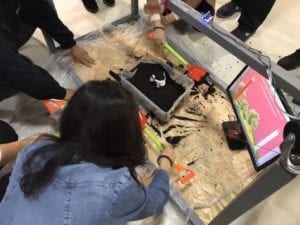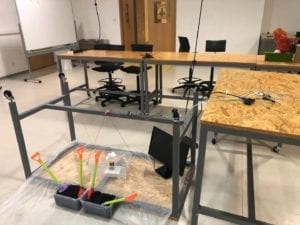Our Planet—Vivien Hao—Professor Inmi Lee
CONCEPTION AND DESIGN:
We have made some small changes after the user testing. Like what Professor Marcele has suggested, if we put the two boxes of sand on the two sides, it might make participants feel like they are in a competition, which we do not want to see. We want to promote cooperation. In addition, participants had a hard time seeing the screen. So they did not understand what the purpose behind planting a tree is. With all these confusions from the participants in mind, my partner and I decided to move the screen to an eye-level, at which participants can easily see the image of a growing tree. Instead of using sand, we have filled the boxes with dirt because participants would grab the idea of planting a tree well if we use dirt instead of sand. We think that when the participants can see the growing tree in front of then, they would understand why they have to dig dirt and plant the trees. For this project, we were very careful with the choice of materials. Since the message we want to communicate is a global issue, so in this process, we did not want to raise other global issues such as wasteful usages of materials. We want to be as much environmental-friendly as possible. We used reusable boxes to put dirt. We placed the weight sensor on the table without destroying neither the sensor nor the table. We knew that we did not want to destroy anything in this process, if possible. I think because we had this belief since the beginning, so throughout the material selection process, we knew clearly what are the materials that we would not consider due to the unsustainable issue they might have. In the beginning, we had the idea of laser cutting four boxes. And use those four boxes as containers for dirt. But we then rejected this idea because if we did so, we could have wasted so many materials. And certainly enough, a better solution would be to use reusable plastic boxes. By using reusable plastic boxes, we could well communicate our idea of being environmental-friendly.
FABRICATION AND PRODUCTION:
In the User Testing Session, we have encountered several issues that we did not previously thought might have occurred, such as participants did not know what they were supposed to do, they did not understand the purpose of planting a tree, participants treated the cooperation process as a competition, we did not have enough dirt, etc. After the user testing, we knew clearly that we have to make changes to solve these issues. We added a monitor screen that could display the growing tree. We placed the monitor on the floor so that participants can see the outcomes directly. We have also placed the weight sensor on a table so that it would be more stable than just simply grabbing it by hand. These changes could not have been made if we did not have the User Testing Session. We could not have seen those issues. I think these changes were very effective. In the final presentation, we could see that participants knew what to do. Like I have mentioned earlier, in this project, we wanted to be as much environmental-friendly as possible. So we have tried to only to use reusable materials throughout the process. This resonates with our overall project goal—to make people aware of the global warming issue—and with such a goal in mind, so we wanted to communicate this idea throughout the entire project.


CONCLUSIONS:
The goal of this project is to raise people’s awareness of the global warming issue that we are currently encountering. Throughout the project, we encourage interactions between the participants and the project. We also encourage cooperation among the participants. Through this cooperation process, interaction occurs. Participants need to cooperate simultaneously in order for the project to give a satisfying outcome. However, I think this part could have been more interactive if we have made the project offer a second response to the participants. For the current project, people could only see one outcome—the earth will explode no matter what. The audience did participate in a way that we wanted them to participate in. They were willing to cooperate with each other throughout the process and understand the final outcome would be the earth will explode no matter what we do. I think if we had more time, we could have enlarged the project by size. We could have added more dirt so that more participants could join the game, and by have enough participants to play this game, the earth will not explode. By doing that, we would not be so pessimistic. I think throughout this project, we have been very pessimistic. And from the feedback we have gathered from the participants, we know that we could have been more optimistic. I have learned that no matter how terrible the situation might be, we have to be optimistic and always have hope. Even though we know that due to our irresponsible actions, the earth is facing serious dangers, we still need to try to put in the effort and save the earth. Throughout the process of building this project, we were very on-schedule. We did not really push things till the last minute. We did not have to pull all-nighters in the lab the night before the deadlines. I think this is one of our most noticeable accomplishments. Through this imperfect project, we really want to make people aware of the fact that our home planet is facing serious dangers due to our irresponsible action. We have to take immediate actions. We have to, and we must care about this planet.